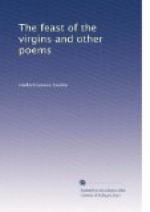[80] The animal called by the French voyageurs the cabri (the kid) is found only on the prairies. It is of the goat kind, smaller than a deer and so swift that neither horse nor dog can overtake it. (Snelling’s “Tales of the Northwest,” p. 286, note 15.) It is the gazelle, or prairie antelope, called by the Dakotas Ta-toka-dan—little antelope. It is the Pish-tah-te-koosh of the Algonkin tribes, “reckoned the fleetest animal in the prairie country about the Assiniboin.” Captivity and Adventures of John Tanner, p. 301.
[81] The Wicastapi Wakanpi (literally, men supernatural) are the “Medicine-men” or Magicians of the Dakotas. They call themselves the sons or disciples of Unktehee. In their rites, ceremonies, tricks and pretensions they closely resemble the Dactyli, Idae, and Curetes of the ancient Greeks and Romans, the Magi of the Persians and the Druids of Britain. Their pretended intercourse with spirits, their powers of magic and divination, and their rites are substantially the same, and point unmistakably to a common origin. The Dakota “Medicine-Man” can do the “rope trick” of the Hindoo magician to perfection. The teepee used for the Wakan Wacipee—or Sacred Dance—is called the Wakan Teepee—the Sacred Teepee. Carvers Cave at St. Paul was also called Wakan Teepee because the Medicine-men or magicians often held their dances and feasts in it. For a full account of the rites, etc., see Riggs’ Tahkoo Wahkan, Chapter VI. The Ta-sha-ke—literally, “Deer-hoofs”—is a rattle made by hanging the hard segments of deer-hoofs to a wooden rod a foot long—about an inch in diameter at the handle end, and tapering to a point at the other. The clashing of these horny bits makes a sharp, shrill sound something like distant sleigh-bells. In their incantations over the sick they sometimes use the gourd shell rattle.
The Chan-che-ga—is a drum or “Wooden Kettle.” The hoop of the drum is from a foot to eighteen inches in diameter, and from three to ten inches deep. The skin covering is stretched over one end, making a drum with one end only. The magical drum-sticks are ornamented with down, and heads of birds or animals are carved on them. This makes them Wakan.
The flute called Cho-tanka (big pith) is of two varieties—one made of sumac, the pith of which is punched out. The second variety is made of the long bone of the wing or thigh of the swan or crane. They call the first the bubbling chotanka from the tremulous note it gives when blown with all the holes stopped. Riggs’ Tahkoo Wahkan, p. 476, et seq.




